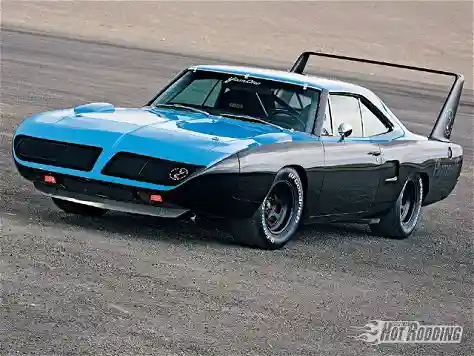

In the annals of automotive history, the 1970 Plymouth Roadrunner Superbird stands as a testament to engineering brilliance and racing dominance. A modified iteration of the Plymouth Road Runner, this automotive marvel was meticulously crafted to conquer the NASCAR tracks, leaving an indelible mark on the racing world. With its potent engine and distinctive aerodynamics, the Superbird remains an icon, a sought-after collector’s item even in contemporary times.
Speed Unleashed:
The Superbird was not just a car; it was a speed demon on wheels. With a top speed surpassing the 200 mph mark, it held the title of one of the fastest production cars of its era. Accelerating from 0 to 60 mph in a mere 5.5 seconds and conquering a quarter-mile in just 14 seconds, the Superbird’s performance was unparalleled. Moreover, its aerodynamic features, including the pointed nose, flush-mounted headlights, fender air scoops, and the towering rear wing, significantly reduced drag. Consequently, this design provided the optimal balance of speed and control, enhancing the overall performance of the vehicle. Furthermore, the meticulous attention to aerodynamic details not only improved its speed capabilities but also contributed to the vehicle’s aesthetic appeal.
Specifications at a Glance:
The Superbird offered enthusiasts three engine options, each with its own set of specifications and performance levels. From the base 440 cubic inch V8 with a four-barrel carburetor generating 375 horsepower to the mighty 426 cubic inch Hemi V8, boasting 425 horsepower, the Superbird catered to those with a taste for raw power. Accompanied by a four-speed manual or three-speed automatic transmission, the Superbird weighed approximately 4,100 lbs, with a wheelbase of 115 inches. A fuel tank capacity of 18 gallons and a fuel economy of about 10 mpg rounded out its specifications.
| Engine | Power | Torque | Transmission | Weight | Wheelbase | Fuel Capacity | Fuel Economy |
|---|---|---|---|---|---|---|---|
| 440 cubic inch V8 | 375 hp | 480 lb-ft | 4-speed manual or 3-speed auto | 4,100 lbs | 115 inches | 18 gallons | 10 mpg |
| 440 cubic inch V8 | 390 hp | 490 lb-ft | 4-speed manual or 3-speed auto | ||||
| 426 cubic inch Hemi V8 | 425 hp | 490 lb-ft | 4-speed manual or 3-speed auto |
Read More:
Luxurious Interior:
Step inside the Superbird, and you’ll find a blend of comfort and performance. Similar to its Road Runner counterpart, the interior featured a vinyl bench or optional bucket seats, adorned with a floor-mounted shifter and console. The special Rallye instrument cluster boasted a 150 mph speedometer, tachometer, and gauges for oil pressure, water temperature, fuel level, and ammeter. With room for five passengers and a cavernous trunk boasting a 15.1 cubic feet capacity, the Superbird ensured a luxurious driving experience.
Engineering Marvel:
Behind the Superbird’s prowess lay a collaborative effort between Plymouth and Petty Enterprises, the latter led by none other than the iconic Richard Petty, revered as “The King” of NASCAR. This partnership resulted in an engineering spectacle, where experts from Chrysler and Creative Industries joined forces to tweak and optimize various elements such as the nose cone, rear wing, engine, suspension, and brakes. Extensive testing in wind tunnels and on tracks ensured that the Superbird not only met but exceeded expectations.
Triumphs and Challenges:
The 1970 Plymouth Roadrunner Superbird roared into the NASCAR circuit, clinching victories and setting records. Its unique and futuristic design captured the public’s imagination.However, despite the challenges, the journey was not without its hurdles. High production costs, coupled with sluggish sales and evolving NASCAR regulations, prompted the production of only 1,935 units for a single year. Nevertheless, the resilience of the team and the dedication to quality ensured that each unit produced met the highest standards. In addition, despite the limited production, the reception from enthusiasts and collectors alike was overwhelmingly positive. Today, the Superbird remains a rare and invaluable automotive gem, cherished by a devoted fan base and leaving an enduring legacy in the rich tapestry of racing history.